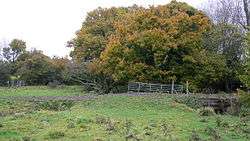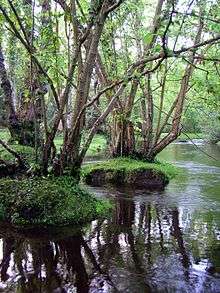Oakhanger Stream
Oakhanger Stream is a tributary of the River Slea that lies in Hampshire, England.
| Oakhanger Stream | |
|---|---|
 Footbridge over the Oakhanger Stream near the village of Oakhanger | |
| Location | |
| Country | England |
| Counties | Hampshire |
| Districts / Boroughs | East Hampshire |
| Towns | Selborne |
| Physical characteristics | |
| Source | Well Head |
| • location | Noar Hill, Selborne |
| • coordinates | 51°05′21″N 0°56′24″W |
| • elevation | 126 m (415 ft) |
| Mouth | River Slea |
• location | Kingsley |
• coordinates | 51°07′57″N 0°52′52″W |
• elevation | 72 m (235 ft) |
| Length | 8.343 km (5.184 mi) |
| Basin size | 18.703 km2 (7.221 sq mi) |
| Basin features | |
| River system | Wey catchment |
| Tributaries | |
| • left | Gracious Street Stream |
Course
The source is at Well Head, at the foot of Noar Hill, to the south of Selborne. The initial section towards Selborne is known as the Well Head Stream, the route was diverted in 1894 to provide a supply of water to the village in memory of Gilbert White. At Dorton, on the north side of Selborne, it is joined by the Gracious Street Stream.[1] From Selborne, now known as the Oakhanger Stream, it passes through the village of Oakhanger then skirts the east side of Shortheath Common and on towards Kingsley where it joins the Slea.[2]
Watermills
There were, at least, two corn mills on the Oakhanger Stream, the Old Mill in Selborne, a Grade II listed building now used as a private residence,[3] and Dorton Mill, midway between Selborne and Oakhanger, of which no trace is now visible.[4]
Water quality
The water quality of the Oakhanger Stream was as follows in 2016:
| Section | Ecological Status | Chemical Status | Overall Status | Length | Catchment | Channel |
|---|---|---|---|---|---|---|
| Oakhanger Stream[5] | style="background: #ffd784; text-align: center;" | Poor | style="background: #7af58a; text-align: center;" | Good | style="background: #ffd784; text-align: center;" | Poor | 8.343 km (5.184 mi) | 18.703 km2 (7.221 sq mi) | |
The reasons for not reaching good status is due to agricultural and waste water pollution.
References
- White, Gilbert. "17 October 1790". The Natural History of Selborne. Retrieved 7 July 2020.
- 'The parish of Selborne', in A History of the County of Hampshire: Volume 3, ed. William Page (London, 1908), pp. 4-16. British History Online http://www.british-history.ac.uk/vch/hants/vol3/pp4-16 [accessed 7 July 2020].
- Historic England. "The Old Mill (1174787)". National Heritage List for England. Retrieved 22 June 2020.
- "Dorton Mill, Selborne". The Mills Archive. Retrieved 22 June 2020.
- "Oakhanger Stream". Catchment Data Explorer. Environment Agency.
